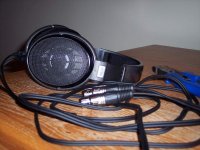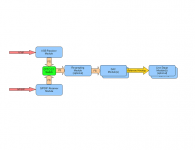driving balanced heaphones 
So I took a HD650 cable and modded it for balanced XLR.
I am driving it directly from the ballsie. It does not seem o have any issues driving the 300ohm load. Though, ultimately it will be a new balanced head amp driving the cans.
Cheers!
Russ
So I took a HD650 cable and modded it for balanced XLR.
I am driving it directly from the ballsie. It does not seem o have any issues driving the 300ohm load. Though, ultimately it will be a new balanced head amp driving the cans.
Cheers!
Russ
Attachments
Re: Now this I like! 
Russ,
Any chance you could list out the order of the chain of modules in that pic?
Thanks!
Scott
Russ White said:I decided to show the COD with TXD I/V and a Joshua Tree attenuator after each I/V, the output of the attenuator goes to the ballsie where the output is filtered and buffered.From there SE outputs go to my head amp and balanced out to the power amp.
Russ,
Any chance you could list out the order of the chain of modules in that pic?
Thanks!
Scott
Sure.  This is the setup:
This is the setup:
WM8804 -(I2S)-> Metronome-(I2S)->COD-(balanced I-OUT)->TXD/IVx2-(balanced V-OUT)->JTx2-(attenuated balanced V out 750R output impedance)-->Ballsie-(LPF single ended and balanced OUT 10R output impedance)--> jacks.
I have been using the metronome at 96khz/24-bit I2S out. The reason is that it just seems to sound better to me than at 192khz. I think its because the chips (both Opus and COD) do better filtering at 96khz than at 192. Also I think the better SNR at that sample rate may play a part.
There is one LCBPS that supplies the ballsie and the pair of TXDs.
There is one LCDPS that supplies the rest. One regulated voltage for the DAC, the other for the metronome and the receiver.
I am using just the basic JT controller which has it own power supply.
I use two dual secondary toroidal trafos. One powers the analog LCBPS on its own. The other powers the JT and the LCDPS. One secondary powers both the JT and one side of the LCDPS. I use this secondary on the same side of the LCDPS that powers the receiver and the metronome. The other secondary is for the other side of the LCDPS, the DAC side.
At some point I will add an OTTO and a USB receiver.
Cheers!
Russ
WM8804 -(I2S)-> Metronome-(I2S)->COD-(balanced I-OUT)->TXD/IVx2-(balanced V-OUT)->JTx2-(attenuated balanced V out 750R output impedance)-->Ballsie-(LPF single ended and balanced OUT 10R output impedance)--> jacks.
I have been using the metronome at 96khz/24-bit I2S out. The reason is that it just seems to sound better to me than at 192khz. I think its because the chips (both Opus and COD) do better filtering at 96khz than at 192. Also I think the better SNR at that sample rate may play a part.
There is one LCBPS that supplies the ballsie and the pair of TXDs.
There is one LCDPS that supplies the rest. One regulated voltage for the DAC, the other for the metronome and the receiver.
I am using just the basic JT controller which has it own power supply.
I use two dual secondary toroidal trafos. One powers the analog LCBPS on its own. The other powers the JT and the LCDPS. One secondary powers both the JT and one side of the LCDPS. I use this secondary on the same side of the LCDPS that powers the receiver and the metronome. The other secondary is for the other side of the LCDPS, the DAC side.
At some point I will add an OTTO and a USB receiver.
Cheers!
Russ
Russ White said:I have been using the metronome at 96khz/24-bit I2S out. The reason is that it just seems to sound better to me than at 192khz. I think its because the chips (both Opus and COD) do better filtering at 96khz than at 192. Also I think the better SNR at that sample rate may play a part.
Does the metronome make a very big difference on the sound? How different is it compared with the same setup minus the metronome?
-Scott
scottj said:
Does the metronome make a very big difference on the sound? How different is it compared with the same setup minus the metronome?
-Scott
Big? Maybe not big, but yes there is a positive difference. The only way I can describe it is that things just seem to sound more clear and liquid. This effect is present accross the board, not just for any particular band. Bass, mids, and treble all seem to sound better to me. More natural, possibly more analog.
Now this is at 96/24. At 192/24 I start to notice a bit of harshness in the mids, but I think this is more from the DAC than anything else. Changing the sample rate changes the way the DAC can apply its digital filters.
I will be trying 192/24 again with Wolfson WM8741 as I think it will do better in this regard than either the WM8740 or the PCM1794. It has a new filtering process that is supposed to significantly reduce pre-ringing. I have been thinking it may well be this pre-ringing I hear at 192/24. The COD, and Opus seem to be effected by this phenomenon in the same way, as I find they both sound better to me at 96/24.
In short, I like it.
You can easily use something like the OTTO to switch the metronome completely in and out. Or simply use the bypass option if you want to retain the master clock of the metronome. Then you can make your own A/B comparisons.
Cheers!
Russ
b-square said:Russ,
Have you tried either 176.4kHz or upsampling twice, once to 48kHz and from there to 192kHz? I've noticed some upsampling artifacts being amplified when dealing with largish, non-integer multiples.
bb
I have not tried it yet. I have though about changing crystals and trying some unconventional clocks.
It would nice to try other clocks with Metro. Does this require changing the oscillator?
According to Mr. Wavelength, integer multiples would sound better http://www.audioasylum.com/forums/pcaudio/messages/2/28189.html
According to Mr. Wavelength, integer multiples would sound better http://www.audioasylum.com/forums/pcaudio/messages/2/28189.html
glt said:It would nice to try other clocks with Metro. Does this require changing the oscillator?
Yes it does. Fortunately. that type oscillator come in many frequencies.
Russ White said:
Yes it does. Fortunately. that type oscillator come in many frequencies.
Russ,
I would like to put in a feature request for the next version of the Metronome.
Thanks!
Scott
scottj said:
Russ,
I would like to put in a feature request for the next version of the Metronome.I would like to be able to change the frequency without having to swap out crystals. Even multiples of 44.1 and 48 are my main goals here (176.4 and 192). And like b-square mentioned, upsampling once to 48kHz and from there to 192kHz seems like a good path as well. Is this doable? Is it even practical? Or perhaps do I just need a design that supports two separate crystals?
Thanks!
Scott
No matter what, you have to change the reference clock to get those kinda of differences. You also need to reset the device when you change reference clock frequencies. So it's not exactly simple to change on the fly. Changing the freq itself is not that hard.
On the production metronome (V. 1.1) there is a jumper to disable the onboard reference clock. If you disable it you can then input an external reference clock.
You can actually do it in the V1.0 boards too, you just need to pull the enable pin(pin #1) on the XO low to disable it.
The up sampling twice thing is really easy. Just use two of the new boards and disable one of the boards ref clock and on that board input the live clock from the other board.
Cheers!
Russ
glt said:It would nice to try other clocks with Metro. Does this require changing the oscillator?
According to Mr. Wavelength, integer multiples would sound better http://www.audioasylum.com/forums/pcaudio/messages/2/28189.html
The SRC4192 doesn't care whether you use integer multiples or not.
Spartacus said:
The SRC4192 doesn't care whether you use integer multiples or not.
I actually fully agree with this.
All of the things I have noticed I think I can lay squarely at the feet of the DACs involved.
But while the SRC4192 doesn't care about integer multiples, isn't there still a possibility that it could have difficulty performing the 4.354x upsample from 44.1 to 192? I am by no means an expert on this, but I have seen similar issues in image conversion software.
-Scott
-Scott
Hi Scottie,
if you look at the SRC4192 datasheet, it will show that there is no correlation between whether it's using integer multiples and the quality of the output. The AD1896 on the other hand likes to work with integer multiples - again this is shown in its datasheet.
if you look at the SRC4192 datasheet, it will show that there is no correlation between whether it's using integer multiples and the quality of the output. The AD1896 on the other hand likes to work with integer multiples - again this is shown in its datasheet.
Russ White said:All of the things I have noticed I think I can lay squarely at the feet of the DACs involved.
Ok guys, I've just done some reading on how ASRCs work, and I think I'm getting it now. The idea of the problem being in the DAC certainly does make sense. Is there a better DAC that we can swap in to try out?
-Scott
Is it possible to use the COD with the included resistor (passive I/V) and capacitors directly (no buffer stage) into a 40Kohms input impedance balanced power amplifier ?
What is the max output voltage of the COD using included resistor ?
What is the COD module output impedance after the included resistor ?
thank you very much
What is the max output voltage of the COD using included resistor ?
What is the COD module output impedance after the included resistor ?
thank you very much
- Status
- This old topic is closed. If you want to reopen this topic, contact a moderator using the "Report Post" button.
- Home
- More Vendors...
- Twisted Pear
- COD - Current Output DAC

